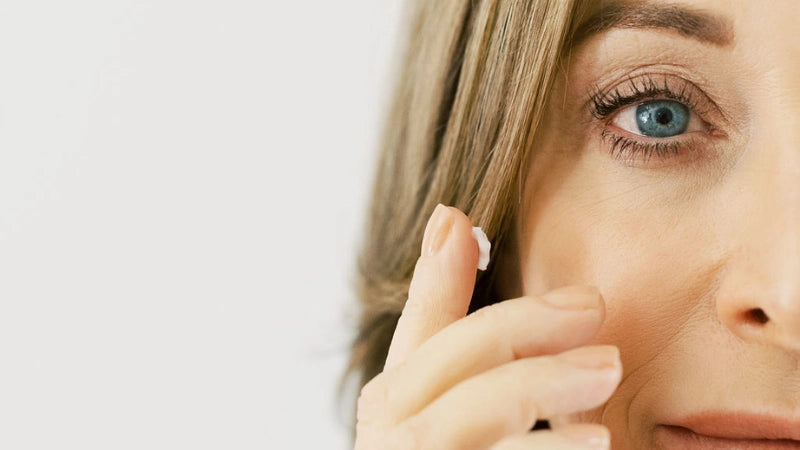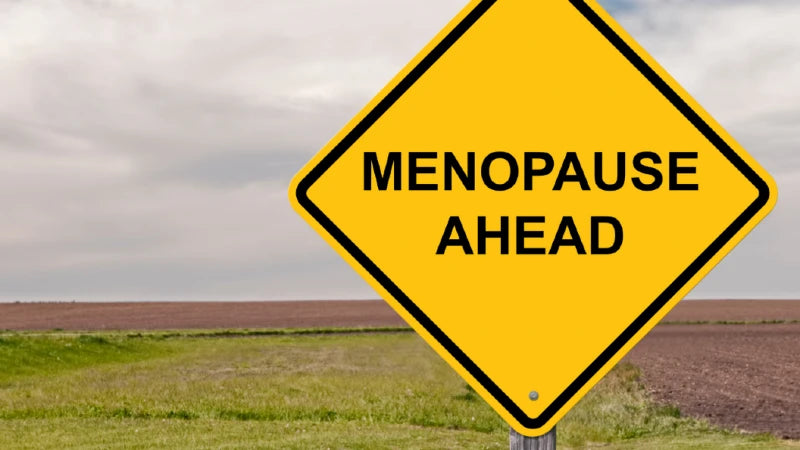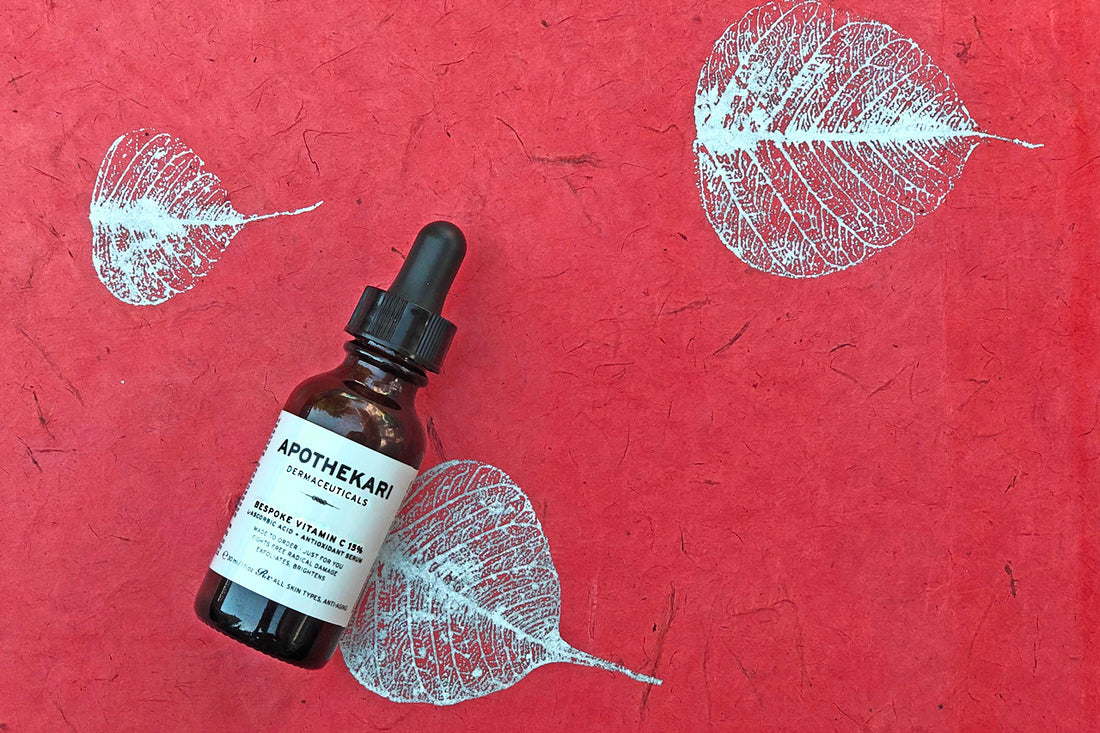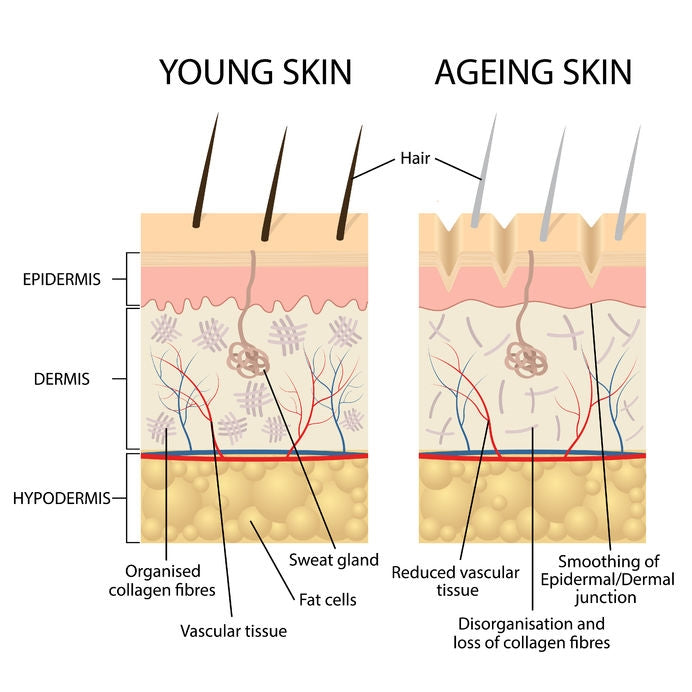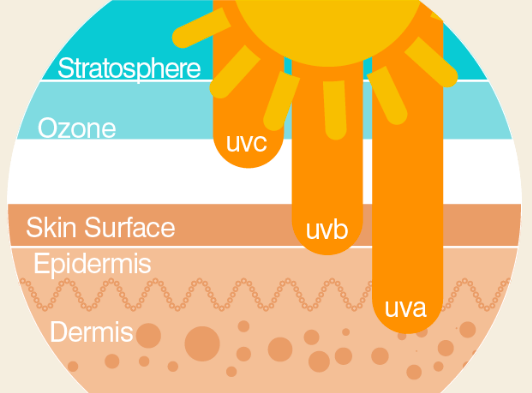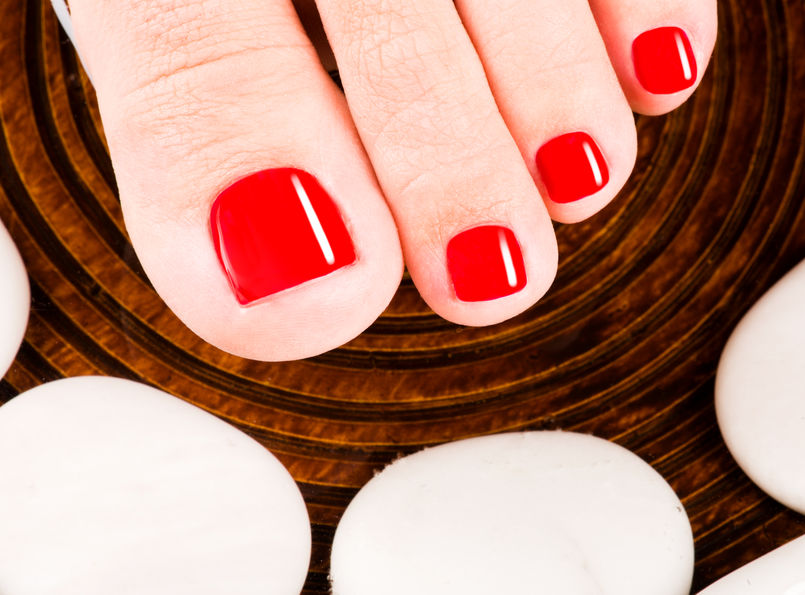Blog
Body Care 101: Why Skincare Shouldn’t Stop at Your Face
Featuring Apothekari favorites like Bamboo Lemongrass Foaming Body Polish, Shea Body Butter, and Natural Deodorant Spray, it guides readers through a simple, science-backed routine to care for their skin from head to toe. Because skincare doesn’t stop at your chin—it’s self-care for your whole body.
Learn moreHow To Look After Your Aging Skin: A Pharmacist's Guide to Skincare After 50
If you’re seeking the inside scoop on aging skin care, step into the laboratory of skincare wisdom. Our founder, Sharmani, a pharmacist and a mature woman herself, expertly blends science with style to unveil the art of aging gracefully. Ready for a journey that’s as scientific as it is fabulous? Shop Active Treatment Serums Is 45 Too Late to Start A Skincare Routine? It’s never too late! Dive into the world of timeless beauty with three main products, the Holy Grail for mature skin: Sunscreen Vitamin C (like the triple combination of vitamin C and antioxidants found in our Glow Getter3 Serum) Retinoids, like the powerful, yet gentle retinaldehyde combined with other highly active ingredients in our Advanced+ Renewal Serum. These three products should form the foundation for your aging skin care regimen. What Should My Skincare Routine Be at 50? Whether you started earlier or are just embarking on your serious skincare journey at 50, there’s no wrong time to craft a precise skincare routine. The same principles apply to 50-something skin as it does in your 40s: sunscreen, vitamin C, and retinoids. And because 50-something skin can start to experience dryness, make sure you have a good moisturizer like our Daily Infusion+ on hand. This hydrating powerhouse keeps your skin’s balance in check. How Can I Make My Aging Skin Look Better? To minimize the appearance of wrinkles and fine lines and leave your skin looking radiant and glowing, elevate your skincare routine with our Radiant Skin Set, which combines a morning and nighttime serum (Glow Getter3 and Advanced+ Renewal) for radiant and youthful-looking mature skin. Make sure to use something to combat dryness, which can age skin. Should You Use Retinol in Your 50s? Absolutely, let science lead the way! Retinoids are backed by oodles of evidence to show that they stimulate collagen production, bidding farewell to fine lines and wrinkles. They also increase skin cell turnover, fight hyperpigmentation, and even increase your skin’s moisture content, helping to combat dryness. Think of retinoids as your skin’s secret weapon, deployed under the cover of night. (retinoids should be applied at night because they are sensitive to sunlight and prone to degradation when exposed to UV rays.) We’re huge fans of the benefits that come with retinaldehyde, found in our Advanced+ Renewal Serum. What is the Best Skin Care Routine for Women Over 50? For actual results (not overhyped nonsense), get started with our Ageless Skin Set. In addition to our two serums, Glow Getter3 and Advanced+ Renewal, we include our hydrating Daily Infusion+ Moisturizer and Amazing Clean, an exfoliating cleanser (but caution sensitive skin with this one!) It contains the essentials for better looking skin–just add sunscreen. What is a Good Skin Care Routine for Aging Skin? Crafting a good skincare routine for mature skin isn’t as difficult or as confusing as you may imagine. Start with cleansing, which helps remove dirt and make-up and provides a clean canvas to help absorb other products. Next, prevent damage and protect skin with antioxidants and sunscreen. Finally, add in a retinoid treatment to rejuvenate and perfect skin. Nourishing face oils like our Antioxidant Face Oil and performance moisturizers like our Daily Infusion+ Moisturizer help keep mature skin protected against dryness, which can emphasize the appearance of wrinkles and fine lines. What is the Best Treatment for Aging Skin? The ultimate treatment for mature skin? It’s about finding the right products that work for YOUR skin and using them consistently. Beautiful skin doesn’t happen overnight or by chance. It’s a combination of a number of factors, including your lifestyle, your genetics and the skincare products you use. Eat well, exercise, get enough sleep, manage stress. Then add in scientifically proven ingredients and use them consistently in your skincare routine. Find products and a program that works for you and stick with it. It can take weeks to months to notice a difference. But stay with it, and you’ll reap the benefits. Dos and Don’ts For Skincare After 50 Now, let’s dive into the two most important Dos and Don’ts for skincare after 50. ✅ Do embrace a consistent routine tailored to your skin’s needs. ❌ Don’t skip sunscreen; it’s your best defense against premature aging. Should You Use Anti-Aging Products? Let’s challenge the term “anti-aging.” At Apothekari, we believe in embracing the beauty of getting older. Anti-aging suggests a fight against the natural process of aging, while we encourage a celebration of the journey and caring for your skin gracefully. We’ve long dropped this term from our marketing and we think it’s high time that everyone else does too! How to Care for Oily Mature Skin If you’re dealing with oily aging skin, embrace balance. Cleanse with our Amazing Clean, designed for exfoliation without irritating. Use lightweight moisturizers like our Daily Infusion+ to hydrate without causing excess oil. Retinoids like the retinaldehyde found in our Advanced+ Renewal Serum have been shown to minimize the appearance of blemishes and breakouts due to their impact on managing oil production and antibacterial effects. If you find yourself starting to breakout like you did in your teens, Advanced+ Renewal may just save the day! How Can I Make My Aging Skin Look Better? We really don’t think there’s a better place to start seeing a transformation in your mature skin than by elevating your routine with our Radiant Skin Set. This duo of serums (Glow Getter3 and Advanced+ Renewal) works in harmony for radiant, youthful-looking skin. As you gracefully move through your 60s and 70s, continue with the same Apothekari products that are working for you. There’s no need to change things up because your skin doesn’t become immune to the effects of a good skin care product. If you notice that your skin becomes drier or more sensitive, look for moisturizers that deliver heavy-duty results. Or consider adding in a face oil. You may also notice dryness in areas besides your face. It’s one of the reasons that we developed More Than Lip Service. This vulvar and vaginal moisturizer delivers fast, long-lasting, and hormone-free relief from the pain, burning, and irritation that many women experience down there as they get older. Explore how our range adapts to the evolving needs of your skin, ensuring a radiant and healthy complexion. Here’s to timeless elegance, no matter your age.
Learn moreHow To Fix Menopause Dryness With These Proven Solutions
The bad news—menopause dryness is an inevitable change for women as they age. The main reason for this is due to a drop in hormone levels, primarily estrogen, which leads to some noticeable changes to your skin and hair. The good news? Menopause dryness in all your body’s places is manageable and we’ve got you covered. Read on for all the ways to help turn your skin around. More Than Lip Service is a vaginal and vulvar moisturizer that alleviates the symptoms of dryness down there that occurs in more than 50% of women. Shop Intimate Care Feminine Moisturizer Does Menopause Dryness Go Away? Sadly, the hormonal changes that occur at menopause are permanent. During the lead-up to menopause—perimenopause—and at menopause, your body makes less estrogen, the hormone responsible for maintaining the elasticity, thickness, and suppleness of your skin. And while you may notice drier skin and hair, less obvious places on your whole body, including your neck, back, and chest, to elbows, legs, genitals — even nails, may be affected too. The inside of your mouth, nose, and eyes get drier as you age, as well. You might not think of them as skin, but just like the tissues inside your genitals–they’re called “mucosa,”–hormonal changes impact these as well, leaving you with itchy eye pain, cotton mouth, and that awful sandy feeling in your vagina. Thankfully there are many ways to help you, and your skin, feel better again. What Helps with Dry Skin During Menopause We’ve written about treating dry skin before and many of the tips outlined in these posts and our free guide, can help: Here’s How to Treat Dry Skin as You Get Older Make This One Change to Relieve Dry Skin Make This One Change to Relieve Dry Skin 5 Tips to Help You Care for Your Menopause Skin And you can also download our free guide packed with 7 Powerful—and easy—Tips to Help Banish Dry Skin. Why Am I Dry Down There All of a Sudden? Beyond your skin, hair and nails, you may notice menopause dryness in some unexpected places. Like down there. Estrogen’s impact on your skin also extends to the mucosal tissue found in your vulva and vagina. Low levels of the hormone can lead to thinning, drying, and inflammation of the vaginal walls. Vaginal tissues become more easily irritated. This condition is called vaginal atrophy and can result in: Itching or stinging Burning and pain during sex or urination Light bleeding following intercourse An increased risk for developing urinary tract problems such as urinary tract infections (UTIs) and frequent urination. There are other causes of vaginal dryness as well, including breastfeeding, some medications, and certain medical conditions. Read more about this here: Don’t Put Up With Vaginal Dryness | How to Treat it How do I Treat Vaginal Dryness? Without treatment, vaginal dryness usually worsens over time. And since treatments are available, it’s important to try them to help relieve your symptoms and discomfort. There are 3 main ways to address vaginal dryness: Lubricants Vaginal/Vulvar Moisturizers Hormone Treatments What works for you depends on a number of factors, including personal choice along with trying different products. Many women may start off by using a lubricant but then move to a moisturizer like More Than Lip Service for longer term relief. Hormonal treatments are an option for some women and a discussion with your trusted medical provider is always a good place to start. Can I Use Lube to Moisturize Menopause Dryness? Lubricants are designed to deliver added moisture to your vagina just before sex or pleasuring, but their results are only temporary. Moisturizers on the other hand, deliver longer lasting benefits, keeping your vagina and/or vulva moist all day. Although they work differently and provide different results, you can use lubricants along with moisturizers if that’s what works for you. Vaginal moisturizers like More Than Lip Service are one of the best ways to reduce vaginal and vulvar dryness for the delicate tissue in this part of your body. You can use it daily to begin with, then every few days to help keep the skin and tissues moist and to relieve vaginal dryness symptoms. The moisturizer can also be applied to the vulva to relieve dryness there. Apply before bed to help it maintain contact with tissues. Don’t use moisturizers not meant specifically for this part of your body. What is the Best Vaginal Moisturizer? More Than Lip Service Vulvar and Vaginal Moisturizer offers fast, hormone-relief for when you experience dryness down there. While there are many options to choose from, research has shown that a formulation made with hyaluronic acid (as found in our More Than Lip Service Vaginal Moisturizer), helps to relieve the symptoms of vaginal atrophy, reducing dryness and itching and improving urinary incontinence, comparable to treatment with estrogen therapy. The bonus? It comes without the potential for side effects using hormonal drugs. Int J Community Based Nurs Midwifery. 2016 Jan; 4(1): 69–78. Comparison of the Hyaluronic Acid Vaginal Cream and Conjugated Estrogen Used in Treatment of Vaginal Atrophy of Menopause Women: A Randomized Controlled Clinical Trial Azam Jokar, MS,1 Tayebe Davari, MS,2 Nasrin Asadi, MD,3 Fateme Ahmadi, MD,4 and Sedighe Foruhari, MS1 Vaginal moisturizers are also available in creams, suppositories and natural oils. The key is to find one that works for you. Menopause Dryness Natural Remedies Do a search on the internet and you’ll probably find several safe and effective ways to help alleviate menopause dryness. Use caution with where you’re finding the information as not everyone who gives advice is actually qualified to give this advice. Please always consult your doctor before trying out potentially harmful treatments. That said, there are number of things you can do to help manage dryness naturally: Diet. A diet high in essential fatty acids, found in foods like fish and nuts may help to improve vaginal elasticity and tissue strength. As well, soy contains plant estrogens, which may help to reduce vaginal dryness. Last, drink plenty of water to stay hydrated. Limit caffeine and alcohol, which are dehydrating. Exercise. May help to improve blood flow and balance hormone levels. Caution with Personal Care Products. Douches, scented soaps and harsh cleansers may irritate the area and increase dryness. Have More Sex. Studies have shown that sexual intercourse helps to increase blood flow to your vagina, helping to keep tissues health. Remember to use a lubricant to help eliminate dryness and make sex more pleasurable.
Learn more5 Tips to Help You Care for Your Menopause Skin
Menopause marks the date one year after a woman’s last period and it can bring about some noticeable, and often, unwanted changes to your skin and hair. Yup, that includes the dreaded chin hairs! Menopause skin’s appearance can change for many reasons and we’ve written about that before. The production of hormones—our body’s chemical messengers—may increase or decrease, and, the impact of your lifestyle and genes are bound to catch up with you. Shop Intimate Care Feminine Moisturizer Shop Active Treatment Serums These 3 Hormones Have the Most Impact on Your Menopause Skin Our bodies produce lots of hormones, but these 3 are most implicated in the skin changes you may notice. 1. Estrogen The mother of hormones in women, estrogen levels decrease as you age, leading to a drop in collagen and elastin production. Menopause skin ends up being thinner, saggier and more wrinkled. It also becomes drier because estrogen is involved in the production of hyaluronic acid, which helps to keep the skin moist. This can affect the skin not only on your face, but also on the rest of your body and is one of the reasons that so many women experience vaginal dryness as they transition to menopause. 2. Progesterone Like estrogen, progesterone levels drop with age. This hormone has been shown to increase skin thickness and elasticity so a decline will have a noticeable impact on your skin. 3. Testosterone Thought acne was something you only had to suffer through your teen years? Sadly, aging tends to increase testosterone levels and is a reason why women may suffer with acne and blemishes at midlife. Chin hairs? You can blame testosterone for those as well! Ready for better skin? Sign up to our newsletter and take advantage of the tips we’re sharing to help you treat the skin on all your body’s places and age with confidence, comfort and grace. Plus get 10% off your first order! 5 Tips for Radiant, Glowing Menopausal Skin 1. Wear Sunscreen Every Day (And consider adding in an antioxidant) Sun damage accounts for over 80% of skin damage–unprotected exposure to ultraviolet rays contributes to brown spots, thinning skin, dryness and wrinkles. Find a good broad-spectrum sunscreen, with a minimum SPF 30 protection and use it every day, year round. Even in the winter, on cloudy days and when sitting next to a window, long-penetrating UVA rays can lead to damage. Layer on an antioxidant along with your sunscreen to help boost protection against the damaging impact of UV rays—they result in free radicals, unstable molecules that harm skin. There are lots of antioxidants you can choose, green tea, reservatrol, coenzyme Q10, ferulic acid. We love them all but especially vitamin C because it has oodles of research to support its benefits in boosting collagen production, brightening the skin and evening out its tone. You can never use too many antioxidants – the more the merrier! Check out our Bespoke Vitamin C Serum, made with a cocktail of antioxidants and other skin beneficial ingredients to help make your skin glow. 2. What is the Best Moisturizer for Menopause Skin? Menopause skin is drier for several reasons, including a decreased ability to hold onto moisture. It can be an issue especially in areas where the air is dry. Moisturize as much as you need, making sure to include these 3 types of ingredients: Humectants. Water loving ingredients that draw moisture into the skin’s top layer. ie. Hyaluronic acid, glycerin, propanediol Emollients. Prevent water loss and help soften and sooth skin. ie. Oils and butters including shea, squalene, fatty acids and fatty alcohols. Occlusives. Provide a physical barrier to help prevent water loss, while also protecting the skin from external irritants. ie. Waxes, some oils and petrolatum. *some ingredients can be both emollient and occlusive (caprylic/capric triglyceride, glyceryl stearate, squalene, shea butter, etc) Many moisturizers, including our Daily Infusion Moisturizer contain a combination of these 3 ingredients. Especially dry skin can benefit from layering—start off with a serum, follow with a moisturizer and then end with an oil like our Antioxidant Face Oil. 3. Become Friends With a Retinoid Retinoids are backed by multiple studies that show their benefits in helping to reduce fine lines and wrinkles by boosting collagen and elastin production. They also help to increase skin cell turnover, fade age spots, even out pigmentation and soften skin. Give it time – you’ll notice benefits with 3 to 6 months of regular use. Retinoids can irritate skin, so you may want to introduce them gradually. We’re big fans of retinaldehyde, found in our A is for Anti-Aging Serum because it is the most gentle, yet still highly effective form of retinoid. Retinaldehyde also decreases oil production and has antibacterial effects so it can also help to manage blemishes that many women experience at midlife. 4. Be Gentle You may be tempted to throw the kitchen sink at your menopause skin, but too much, is definitely too much! Be selective with the products you choose, watching out especially for those that contain irritating ingredients like drying alcohols and fragrances. Go easy on acids, which can thin skin leaving it open to irritation from external irritants; use gentle cleansers, especially if you have dry skin. And use warm, not hot to shower and wash your face. 5. Pay Attention to the Skin on All Your Body’s Places You pay attention to your face, but are you looking after the skin on the rest of your body? Dry skin is an issue in places you may not have considered—that includes vaginal dryness, which more than 50% of women suffer with during perimenopause and menopause. The burning, itching and painful intercourse associated with vaginal and vulvar dryness can be treated with a vaginal moisturizer. More Than Lip Service is made with hyaluronic acid (an ingredient that hydrates skin and which naturally declines as we age) and vitamin E, to give fast, long-lasting & hormone-free relief from the burning, itching & pain associated with vaginal atrophy, vulvar and vaginal dryness. In clinical studies, the combination was shown to be just as effective as hormonal options, without the risk of side effects associated with hormonal solutions. And, unlike many lubricants that just slip right out, ours not only immediately alleviates dryness symptoms but also lasts so long, you may not even need to use it every day.
Learn moreHere's How to Treat Dry Skin as You Get Older
Here’s how to treat dry skin, an inevitable skin change that comes with aging. In this post, learn about ingredients and tips that will lead to softer, smoother and more touchable skin. At Apothekari, our moisturizers are one of the best ways to manage dryness from head to toe. Shop Moisturizers Why Causes Dry Skin As You Get Older? Your skin ages in two main ways: 1. Extrinsic Aging Extrinsic aging is related to the impact of the environment on your skin. This includes exposure to the sun, pollution and smoke, plus diet and lifestyle factors. Stress, sleep, exercise all contribute to extrinsic aging. Together, they can lead to skin thickening, freckles, age spots and some precancerous changes such as actinic keratosis and skin cancers themselves. The sun’s UV rays damages collagen, elastin and other elements that lead to skin that sags, stretches, and loses its ability to snap back after stretching. Mature skin may also become drier, bruise and tear more easily, and take longer to heal. 2. Intrinsic Aging Intrinsic aging is something that we can’t fight against and which occurs as part of the natural aging process: Thinning of the dermal and epidermal skin layers, resulting in a smaller supply of nutrients to the cells A decline in the production of new skin cells and skin supportive fibers (collagen, elastin, etc) A decreased ability to retain moisture A decline in levels of the hormone, estrogen. Estrogen not only stimulates oil glands, which helps keep skin hydrated, it also helps to maintain the skin’s structure. Dryness affects the skin on all of your body. This includes your face, arms and legs, plus parts of your body, you may not have considered, like your vulva and vagina. More Than Lip Service Vulvar and Vaginal Moisturizer offers fast, hormone-relief for when you experience dryness down there. What is the Best Natural Ingredient for Dry Skin? Whether skin is mature or younger, a good moisturizer is key to help treat dry skin. Moisturizers work by either providing hydration, or by helping to prevent its loss, and they contain 3 main classes of ingredients: Humectants: Help to attract moisture to the skin. Glycerin, hyaluronic acid, urea and aloe vera are humectants. Emollients: Smooth and soften skin by helping to repair cracks in the skin barrier. They prevent moisture loss. Butters, oils, esters, lipids, and fatty acids are all considered emollients. Occlusives: Work by forming a protective coating on your skin’s surface, forming a protective barrier that locks moisture in and keeps harmful particles out. They tend to be oily or waxy. Petrolatum, lanolin, beeswax, jojoba oil, and olive oil are examples. Occlusives like oils, can also be emollients. Each class of ingredient provides benefits of its own, and they’re often combined together for the best results. For best results apply them to slightly damp skin to help lock in the moisture. What is the Best Thing for Dry Skin | Top Tips Using moisturizer is an essential step in dry skin management, but there are many lifestyle changes that you can implement to help as well: Introduce Humidity. The drier the air, the drier the skin. It’s a lesson, I re-learn every time I travel to the desert-like climate in Arizona. Consider using a humidifier in the room where you spend the most time, which, for many of us, is the bedroom. Change Up Your Diet. Increasing your intake of foods rich in omega-3 fatty acids has been shown to help improve the skin’s oil production, improve hydration and minimize the signs of aging. Look for them in nuts (walnuts are a rich source), olive oil, avocados and salmon. Watch Your Alcohol Consumption. Ah yes, a glass of red wine on a Friday evening is very appealing. We’re not telling you to give it up completely, but alcohol, along with caffeine, act as diuretics that can lead to dehydration and drier skin. Up the water intake to help counteract the effect if you can. Exfoliate. No matter how much you moisturize, dry skin will stay dry without some light exfoliation. For the face, check out our AHA-Mazing Clean Cleansing Gel and our Bespoke Vitamin C Serum, which hydrates and exfoliates as well. Cleanse Gently. Harsh cleansers can strip away skin’s protective natural oils. Choose one that is gentle—the one we’ve linked to above is gentle, yet also effective. Add In An Oil. If you’re already using a moisturizer and skin is still dry, consider adding in an oil. These help to lock in the moisture delivered by a moisturizing cream or lotion, relieving dryness even further. Our Antioxidant Face Oil is a boon to drier skin on the face while our Lemon Rose Body Oil offers luxurious hydration post shower or bath. Water—but, don’t make it hot! Hot water strips away skin’s protective oils. Switch to lukewarm and stay away from hot water when you shower, bathe or wash.
Learn moreThis Serum Can Fight Free Radicals
Learn how to fight free radicals, molecules which can damage skin, by adding this serum to your daily skincare routine. Shop Bespoke Vitamin C 15% What Are Free Radicals? ‘Free radicals’ AKA Reactive Oxygen Species (ROS) impact our health, including that of our skin. They are created in our bodies as a result of exposure to certain different physical or chemical conditions or illness, including pollution, UV rays, some pesticides and smoke along with the consumption of excess alcohol and some fried foods. Free radicals are thought to contribute to diseases such as heart disease, autoimmune disorders (like rheumatoid arthritis), diabetes and degenerative diseases (Huntington’s or Parkinson’s disease) as well as cancer. Age-related changes in our appearance, including a loss of skin elasticity, wrinkles, graying hair, hair loss, and changes in hair texture are also thought to be related to free radicals. That’s why it’s important to fight free radicals. How to Fight Free Radicals in Skin Once free radical damage starts, it’s thought that a ‘cascade’ of damage occurs, producing more free radicals and speeding up the process of cell damage. This buildup of free radicals offers one explanation for why even healthy bodies age and deteriorate over time. Antioxidants are highly stable molecules, which donate an electron to free radicals, reducing their path of destruction and thereby lessening the damage they cause. Because they are so stable, antioxidants can do this without becoming free radicals themselves. Our bodies make several important antioxidants – glutathione, catalase, superoxide dismutase – and we can help to fight free radicals even further by consuming antioxidant rich foods or by applying them topically. One single antioxidant isn’t enough; we benefit from a combination of including the following: Vitamin C Vitamin E Ferulic acid Green Tea Resveratrol Coenzyme Q10. Apothekari Bespoke Vitamin C Serum is made with a combination of antioxidants and designed to fight free radicals, promote collagen synthesis, brighten skin tone and improve the appearance of aging skin. It is available in a 10% (sensitive skin) or 15% concentration (non-sensitive skin) and each bottle is made fresh to order, guaranteeing its potency. Apply to skin daily every morning to fight free radicals leaving skin looking more youthful and radiant. Top Tip: Eat Your Antioxidants While the topical application of antioxidants is beneficial to skin, we can’t discount the importance of nutrition. Fruits, vegetables and spices including onion, garlic, turmeric, cinnamon and ginger are a major source of antioxidants, which can help to reduce the risk of developing certain diseases. Enjoy the variety; it is the spice of life after all!
Learn moreAging Skin: 7 Things That Can Happen
Aging skin – it’s one of those unavoidable side effects of getting older. While we likely appreciate the wisdom, experience and sense of accomplishment that come with age, we may not necessarily applaud what looks back at us in the mirror. Shop Apothekari Ageless Skin Set Our skin ages in one of two ways – intrinsically or extrinsically. Intrinsic aging is the natural process that takes place over the years regardless of outside influences. Our genetic make-up, hormonal and metabolic processes account for intrinsic aging. Extrinsic aging occurs due to external factors such as sun exposure and environmental damage (pollution and smoking, for example). While we can’t necessarily control intrinsic aging, we can generally minimize the impact of extrinsic factors. Aging Skin Symptoms Aging skin tends to appear: Thinner and more transparent Slacker (saggier and looser) More fragile and more prone to damage (bruising) due to thinner blood vessel walls Drier Wrinkled Duller Rougher Unevenly toned. With age spots and possibly lesions. Different in shape In this blog post let’s look at the ways in which skin ages so that in part 2, we can visit some specific strategies to help keep your aging skin looking its very best. 1. Changes in the Epidermis This outer barrier of our skin protects us from environmental insults, such as bacteria and ultraviolet (UV) radiation. Due to the natural aging process and sun exposure, changes occur. The most obvious one occurs at the epidermaldermal junction – the space between the epidermis and the dermis – where a flattening of ridges occurs. This results in less surface contact of the epidermis and dermis and leads to a reduced exchange of nutrients between these two parts. Aging skin doesn’t get as much nourishment. 2. Changes in the Dermis The dermis sits under the epidermis and contains a very complex arrangement of proteins, including collagen and elastin, which are responsible for skin’s strength and elasticity. Fibroblasts (skin cells) start producing fewer proteins: Elastin, which gives our skin elasticity and rebound. The result is sag. Collagen, which gives our skin firmness contributing to a significant reduction in elasticity. The result is thinner more fragile skin. Glycosaminoglycans (GAGs), which help to keep skin hydrated. The result is more dryness. And, there are fewer Blood Vessels, resulting in less blood volume and leaving the area deficient in nutrients. 3. Changes in Fat Tissue The subcutaneous fatty layer (also called the hypodermis) below the skin starts to shrinks, resulting in sagging. Fat is depleted and accumulates in areas including the forehead, the mouth, the eyes, the nose, the jaws and the cheeks. In young skin, fat tissue is widely distributed, but in aged skin fat tends to accumulate in pockets, which droop and sag due to the force of gravity. 4. Hormonal Slowdown A decline in hormone production including estrogen, testosterone and dehydroepiandrosterone (DHEA) occurs. Other hormones such as melatonin, insulin, cortisol, thyroxine, and growth hormone decline too. Certain signaling molecules such as cytokines and chemokines decline as well, leading to the deterioration of several skin functions. Estrogen and progesterone are thought to contribute to skin elasticity. 5. Gravity Over time, gravity plays a role resulting in an altered distribution of fat, which contributes to sagging. This is particularly prominent in the upper and lower eyelids, on the cheeks, and in the neck region. gravity causes drooping of the eyebrows and eyelids, looseness and fullness under the cheeks and jaw (jowls and “double chin”), and longer ear lobes. 6. Facial Bones and Cartilage Expression lines appear as result of repeated facial muscle movement especially over the forehead and between eyebrows, and in nasolabial folds and eye areas. Repeated folding of the skin during sleeping in the same position on the side of the face contributes to appearance of “sleeping lines.” Bone mass declines and enhances the appearance of facial sagging and wrinkling. 7. Extrinsic Aging Possibly the biggest factor in aging skin is the impact of sun and environmental damage (tobacco use and exposure to pollution, for example), diet and lifestyle factors. These contribute to skin thickening, freckles and sun spots and possibly precancerous changes such as lesions called actinic keratosis and skin cancer (including basal cell carcinoma, squamous cell carcinoma, lentigo maligna melanoma). Over time, the sun’s ultraviolet (UV) light damages elastin, collagen and GAGs which causes the skin to sag, stretch, and lose its ability to snap back after stretching. The skin also becomes drier, bruises and tears more easily and takes longer to heal. The impact of sun damage may not show when you’re young, but it will later in life. As of yet, no one has found an answer to stopping the skin’s natural aging process. But rest assured, science has given us a few tools to counteract its impact. Yes, aging skin is an inevitable process but by starting to take care of your skin at an early age you can help to minimize the damage. All is not lost. In part 2, let’s take a look at this.
Learn moreAll About UV Rays
When it comes to the sun and the damage it can wreak upon skin, it’s the sun’s UV rays that we’re concerned about most. In this post I discuss the different types of UV rays and the impact they have on your skin. Plus, I’ll look at ways to protect yourself. Shop All Apothekari The sun emits all kinds of electromagnetic radiation, with 99% of it being rays in the form of visible light, ultraviolet (UV) rays and infrared rays. Visible light helps us see, infrared rays help keep us warm and UV rays carry energy. When it comes to skin, we are concerned with UV rays because the energy contained in them can change the chemical structure of molecules, causing cell damage and possibly deformities by actually mutating its genetic code. About UV Rays There are 3 main types of UV rays – UVA, UVB and UVC. UVA rays have the longest wavelengths, followed by UVB, and UVC rays which have the shortest wavelengths. UV-C is the most energetic and most harmful; UV-A is least energetic and least harmful. Fortunately, UVC rays break apart when they reach the earth’s protective ozone layer so the sun’s UVC rays never reach us. UVC rays can be man-made (as in welding) and they are just as dangerous as the natural ones. UVA and UVB rays reach the earth’s surface and both can be detrimental to our health. Most of the UV rays you come in contact with are UVA with a small amount of UVB: UVB rays have a short wavelength and reach the outer layer of your skin (the epidermis). They are responsible for Burning skin. UVA rays have a longer wavelength and can penetrate the middle layer of your skin (the dermis). They are responsible for Aging skin. Both types of rays can contribute to skin cancer with prolonged exposure. Some medicines, including antibiotics, birth control pills, and topical benzoyl peroxide products, along with some cosmetics, may increase skin and eye sensitivity to UV rays. Tanning booths, mercury vapor lighting (often found in stadiums and school gyms), some halogen, fluorescent, and incandescent lights and some types of lasers are also sources of UV radiation. What About Vitamin D? Although you need exposure to UVB radiation to help produce vitamin D, the amount of exposure necessary depends on several factors including: Your Skin Colour (Darker skin requires longer exposure to UVB rays to produce Vitamin D) Sunscreen Use and Clothing Where You Live (latitude and altitude). UV rays are strongest in areas close to the equator and lower in areas further from the equator because the sun is farther away. Higher altitudes have greater UV exposure because there is less atmosphere to absorb UV rays. Snow, sand, pavement, and water can increase UV exposure due to their reflective properties. How To Be Sun Safe The best way to protect your skin against UV ray damage is to reduce the amount of time you spend in the sun, particularly between the hours of 10 am and 4 pm, when the sun is at its highest in the sky. While this isn’t always possible, there are some additional ways you can protect yourself: Stay out of the sun during the peak sun hours of 10am and 4pm, especially during the summer. Stay indoors or seek shade. Wear hats, protective clothing and sunscreen to cover yourself. Protect your eyes and the skin around your eyes with a large pair of sunglasses. Wear Sunscreen. This is important, even in cloudy weather. UVA rays can penetrate through clouds (and windows) causing long-term damage. Get into the habit of using sunscreen every day, year round. UV rays surround us daily and are one of the biggest contributors to skin damage. It is possible to protect yourself.
Learn moreOld Lady Feet: And How to Fight Back
Is it just me or is it every woman of a certain age that eventually has to deal with ‘old lady feet’? Hard to define precisely, the topic of old lady feet crops up more frequently at social gatherings where women congregate these days. It becomes particularly more commonplace during warmer weather, when most of us tend to be more conscious of our exposed feet. My feet don’t look that old, but they often really feel it so I guess the term old lady feet applies. While I’ve never really embraced high heels, there was a time that I could put them on and KEEP them on for an entire evening, often even dancing the night away. Now, just the thought of putting on shoes sporting heels higher than 2 ½ inches is enough to make me cringe. These days, comfort trumps all. If you’re one of those women feeling sorry for the lost feet of youth, don’t despair. Our bodies change as we age and feet aren’t immune to this impact. Here are 5 things that happen to our feet as we get older along with some tips to ease the pain: 1. Fat Disappears We’re born with built-in insoles – collagen and elastin, stuffed with fat tissue on the bottoms of our feet. But collagen decreases as we age, thinning out the fat pads and decreasing the cushioning effect. Your feet may be fine in the morning, but can become quite painful at the end of the day. Solution: Before considering fat transplants (expensive and little proof they work), seek out cushioned and comfortable shoes. Wear insoles or gel pads if you need to. Have you noticed how many women have embraced the sneaker look; the rise of the Birkenstock? Coincidence? I think not. 2. Arthritis Develops Our bones and joints can degenerate with age causing pain and morning stiffness. The big toe or the joints on the top of your foot are most likely to be affected. Solution: Try shoe inserts, exercises or losing weight to see if that helps. Seek medical attention if the pain persists. 3. Skin Dries Out The collagen which cushions your feet, also plumps up your skin. A decline in collagen can leave the soles prone to dryness and cracking. Solution: Take care by applying a hydrating foot or body cream. We love Apothekari Shea Body Butter applied after the bath or shower and again when you go to bed. Wearing socks over top of your moisturizing treatment while you sleep can work wonders. 4. Tendons & Ligaments Turn Against You As you age, your body’s ability to hang on to water declines and you can witness this in your tendons, causing stiff ankles and other body parts. On the flip side, other connective tissues called ligaments may stretch out over time, leaving you with fallen arches and a flatter foot. You may not be as well balanced either, leaving you prone to ankle sprains. Solution: Exercise is your best friend here. Try strengthening exercises like ankle circles and toe raises. Calf raises can help to relieve tight ankles. 5. Bunions, Corns and Hammertoes Improperly fitting shoes, anatomical and hormonal changes and genetics may all play a role in the development of these foot complications. Although not medially serious, they may make you feel self-conscious about your feet. Solution: Check in with your doctor or a podiatrist to see if they can help. If you feel a lot of pain, surgery may be recommended. Don’t let old lady feet get you down. A new generation of women now who want fashionable AND comfortable shoes and shoe makers are starting to take notice. Shoes that are functional, supportive AND fashionable are easy to find these days. Sporting low, sturdy heels, cushioned foot beds and rubber soles, this footwear has style to boot. Splash out on a pedicure and go shoe shopping. Here are a few pairs that have caught my eye recently: Clarks Amali Tulip Leather Shoe in Silver Coclico Pop-Up Wedge Stuart Weitzman Nudist June Sandal. Isn’t the pink just divine? Eileen Fisher Black Leather Blog Slide
Learn more


